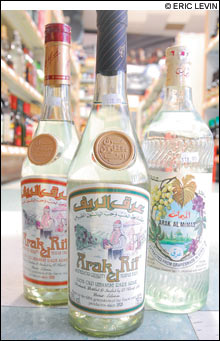.gif) “Alcoholic” and “articulate” rarely appear in the same slurred sentence, but it’s high time they did. After all, the vocabularies of vintners, distillers, brewers, barkeepers, and other pros of the proof the world over are themselves legion; what each consists of — from scientific jargon to slang, archaisms to bastardizations and back again — is all but infinite.
“Alcoholic” and “articulate” rarely appear in the same slurred sentence, but it’s high time they did. After all, the vocabularies of vintners, distillers, brewers, barkeepers, and other pros of the proof the world over are themselves legion; what each consists of — from scientific jargon to slang, archaisms to bastardizations and back again — is all but infinite.
Of course, if you’re quite serious about developing a drunkard’s dictionary, a guzzler’s glossary, a lush’s lexicon, you’d better bone up elsewhere — because we’re not. Behold instead our completely random, totally slapdash list of terms and fun tidbits, specifically designed by us staunch dilettantes for — whom else? — the cocktail-party conversationalist. May you dazzle your fellow boozers with factoids henceforth.
Amontillado
Think of it as sherry’s adolescence: no longer a fino, not yet an oloroso. At either end of the spectrum spanned by Spain’s famed fortified wine, fino sherries — generally drunk as aperitifs — are relatively young, dry, and pale, as well as lower in alcohol content than oloroso sherries, which are older, darker, sweeter, and more appropriate after dinner. Amontillado, meanwhile, is essentially a deflowered fino, having lost the latter’s characteristic layer of yeast, called flor, which retards oxidization and therefore the aging process that deepens a sherry’s color and flavor.
Now, a tapas bar that doesn’t serve sherry is like a burger joint that doesn’t serve Coke — as fishy as it is practically unheard of — so you can be sure to find at least a few selections at your favorite tapería. However, only Taberna de Haro (999 Beacon Street, Brookline, 617.277.8272) actually describes its cute little countertop as a sherry bar, where nips and nibbles are to be taken together before or as dinner.

Arak at Marty's Liquor |
Arak
Like Greek ouzo and Turkish raki (see below), this is an anise-flavored distillate of must — that is, crushed grapes and/or their juice — most often associated with Middle Eastern countries like Lebanon and Syria. Commonly diluted with water and served with ice as an accompaniment to meze, it’s available at Marty’s Liquors (193 Harvard Avenue, Allston, 617.782.3250), for one, which carries a fair selection.Botrytis Cinerea
You might call it nature’s passito. Better known as noble rot (or pourriture noble to those of you fluent in vin-Français), this mold is indirect manna for dessert wine drinkers (provided it develops under the right conditions): it causes the grapes it infects to shrivel, thereby concentrating their sugars. The end result: superior after-dinner sippers, perhaps the most fêted of which is Bordeaux’s liquid-gold sauternes. While this rich, super-smooth near-syrup isn’t hard to spot on high-end wine lists citywide, its availability at a non-French (in fact Italian) restaurant like Prezza (24 Fleet Street, Boston, 617.227.1577), which keeps a few bottles of Château d’Yquem on hand, comes as an especially pleasant surprise at meal’s end (assuming a several-hundred-dollar tab doesn’t subsequently come as a nasty shock, that is).